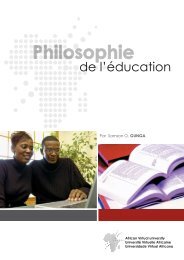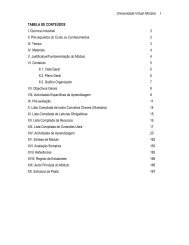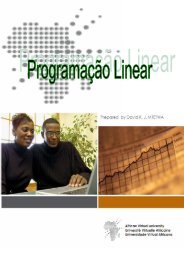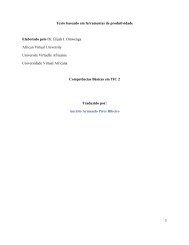Comparative Education.pdf - OER@AVU - African Virtual University
Comparative Education.pdf - OER@AVU - African Virtual University
Comparative Education.pdf - OER@AVU - African Virtual University
Create successful ePaper yourself
Turn your PDF publications into a flip-book with our unique Google optimized e-Paper software.
Stages in Bereday’s <strong>Comparative</strong> Method in <strong>Education</strong><br />
<strong>African</strong> <strong>Virtual</strong> <strong>University</strong><br />
1. Description and data collection: In this stage pedagogical data from various<br />
countries selected for the study is collected and presented using tables<br />
and graphs. The data should be presented in descriptive form to facilitated<br />
further analysis at later stages.<br />
2. Interpretation: This stage involves an analysis of the facts using methods<br />
of different social sciences. For example the researcher could use perspectives<br />
from sociology to explain the varying attitudes of pupils towards social<br />
science studies. Factors in the contextual background such as historical,<br />
geographical, socioeconomic and political factors can be used to explain the<br />
issues that have shaped the educational system.<br />
3. Juxtaposition: In this stage preliminary comparisons of facts and findings,<br />
concepts and principles are used to classify data and process the data. The<br />
criteria for comparability are also set out during this stage.<br />
4. Comparison: This is the final stage of Bereday’s comparative method and<br />
it involves a final fusion of data from other countries for the purpose of<br />
comparison and to derive plans for action. The step also involves hypothesis<br />
testing.<br />
Brian Holmes’ Problem Approach in <strong>Comparative</strong> <strong>Education</strong><br />
Holmes (1969) sets out his argument by stating that early comparative educators<br />
sought to apply learning from other systems for reform purposes. He proposed<br />
the problem serving approach as one that could serve this function, and even<br />
go further to meet the needs of those educators who are interested in theoretical<br />
understanding of educational phenomena. Holmes argues that pioneers of comparative<br />
education were administrators who wished to reform their own systems<br />
of education. Well aware of the dangers of cultural borrowing the administrators<br />
wished to develop methods of comparison to ensure that whatever they chose<br />
to incorporate from foreign theory or practice would benefit their own schools.<br />
They needed a predictive instrument enabling them to foresee as far as possible<br />
the consequences of any innovation. Holmes argues that the problem approach<br />
is the right instrument for addressing educational problems. He points out that<br />
the problem approach presupposes a problem or a limitation in the area inquired<br />
into, and guards against accepting superficial similarities, and assures precise<br />
comparison of actual predicted outcomes.
















